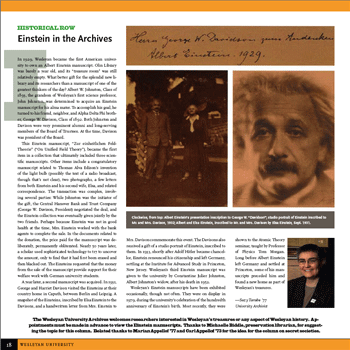HISTORICAL ROW: EINSTEIN IN THE ARCHIVES
 In 1929, Wesleyan became the first American university to own an Albert Einstein manuscript. Olin Library was barely a year old, and its “treasure room” was still relatively empty. What better gift for the splendid new library and its researchers than a manuscript of one of the greatest thinkers of the day? Albert W. Johnston, Class of 1893, the grandson of Wesleyan’s first science professor, John Johnston, was determined to acquire an Einstein manuscript for his alma mater. To accomplish his goal, he turned to his friend, neighbor, and Alpha Delta Phi brother, George W. Davison, Class of 1892. Both Johnston and Davison were very prominent alumni and long-serving members of the Board of Trustees. At the time, Davison was president of the Board.
In 1929, Wesleyan became the first American university to own an Albert Einstein manuscript. Olin Library was barely a year old, and its “treasure room” was still relatively empty. What better gift for the splendid new library and its researchers than a manuscript of one of the greatest thinkers of the day? Albert W. Johnston, Class of 1893, the grandson of Wesleyan’s first science professor, John Johnston, was determined to acquire an Einstein manuscript for his alma mater. To accomplish his goal, he turned to his friend, neighbor, and Alpha Delta Phi brother, George W. Davison, Class of 1892. Both Johnston and Davison were very prominent alumni and long-serving members of the Board of Trustees. At the time, Davison was president of the Board.
This Einstein manuscript, “Zur einheitlichen Feld-Theorie” (“On Unified Field Theory”), became the first item in a collection that ultimately included three scientific manuscripts. Other items include a congratulatory manuscript related to Thomas Alva Edison’s invention of the light bulb (possibly the text of a radio broadcast, though that’s not clear), two photographs, a few letters from both Einstein and his second wife, Elsa, and related correspondence. The transaction was complex, involving several parties: While Johnston was the initiator of the gift, the Central Hanover Bank and Trust Company (George W. Davison, President) negotiated the deal, and the Einstein collection was eventually given jointly by the two friends. Perhaps because Einstein was not in good health at the time, Mrs. Einstein worked with the bank agents to complete the sale. In the documents related to the donation, the price paid for the manuscript was deliberately, permanently obliterated. Nearly 50 years later, a scholar used sophisticated technology to try to uncover the amount, only to find that it had first been erased and then blacked out. The Einsteins requested that the money from the sale of the manuscript provide support for their welfare work with German university students.
A year later, a second manuscript was acquired. In 1931, George and Harriet Davison visited the Einsteins at their country home in Caputh, between Berlin and Leipzig. A snapshot of the Einsteins, inscribed by Elsa Einstein to the Davisons, and a handwritten letter from Mrs. Einstein to Mrs. Davison commemorate this event. The Davisons also received a gift of a studio portrait of Einstein, inscribed to them. In 1933, shortly after Adolf Hitler became chancellor, Einstein renounced his citizenship and left Germany, settling at the Institute for Advanced Study in Princeton, New Jersey. Wesleyan’s third Einstein manuscript was given to the university by Constantine Julier Johnston, Albert Johnston’s widow, after his death in 1952.
Wesleyan’s Einstein manuscripts have been exhibited occasionally, though not often. They were on display in 1979, during the university’s celebration of the hundredth anniversary of Einstein’s birth. Most recently, they were shown to the Atomic Theory seminar, taught by Professor of Physics Tom Morgan. Long before Albert Einstein left Germany and settled at Princeton, some of his manuscripts preceded him and found a new home as part of Wesleyan’s treasures.

